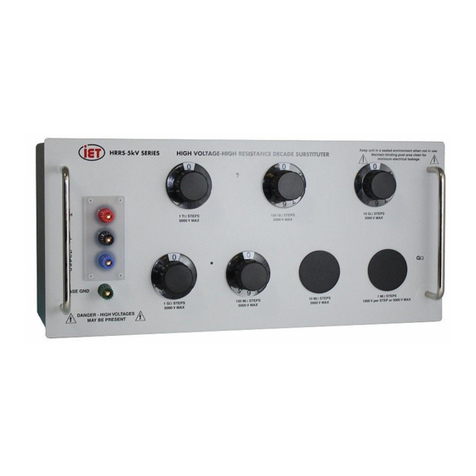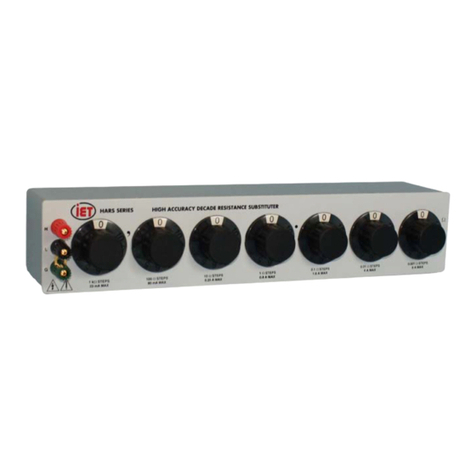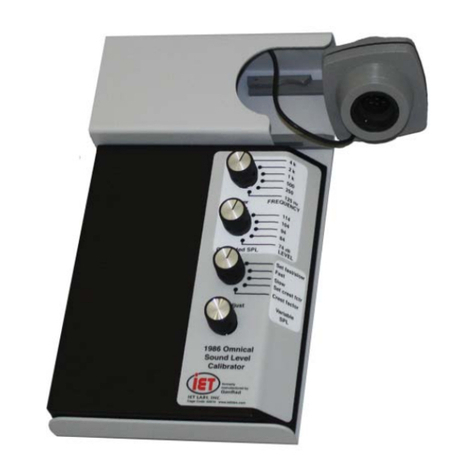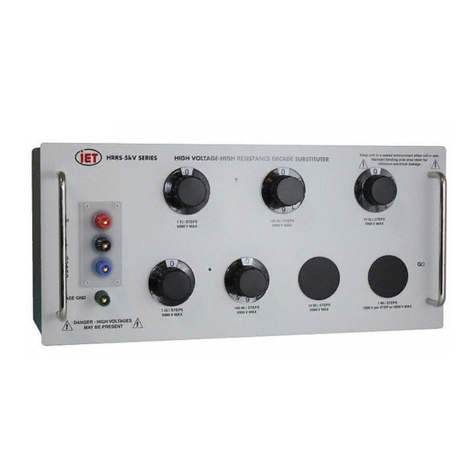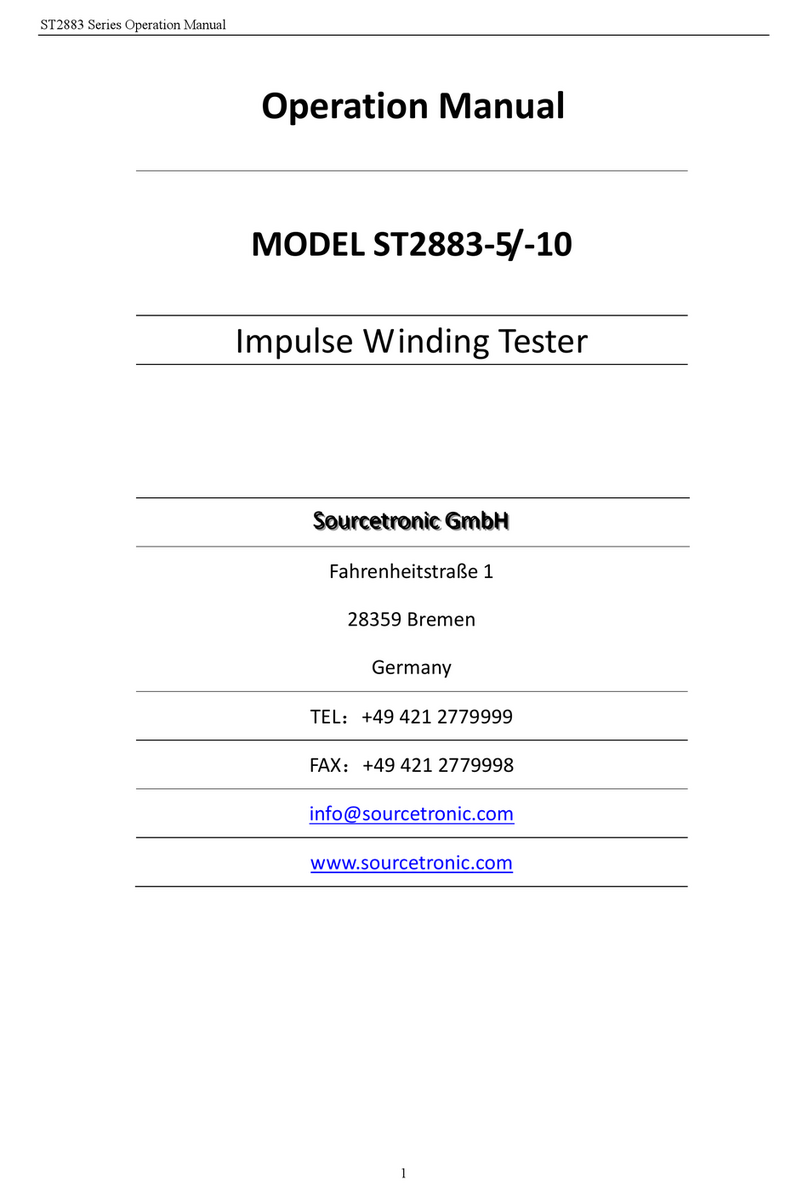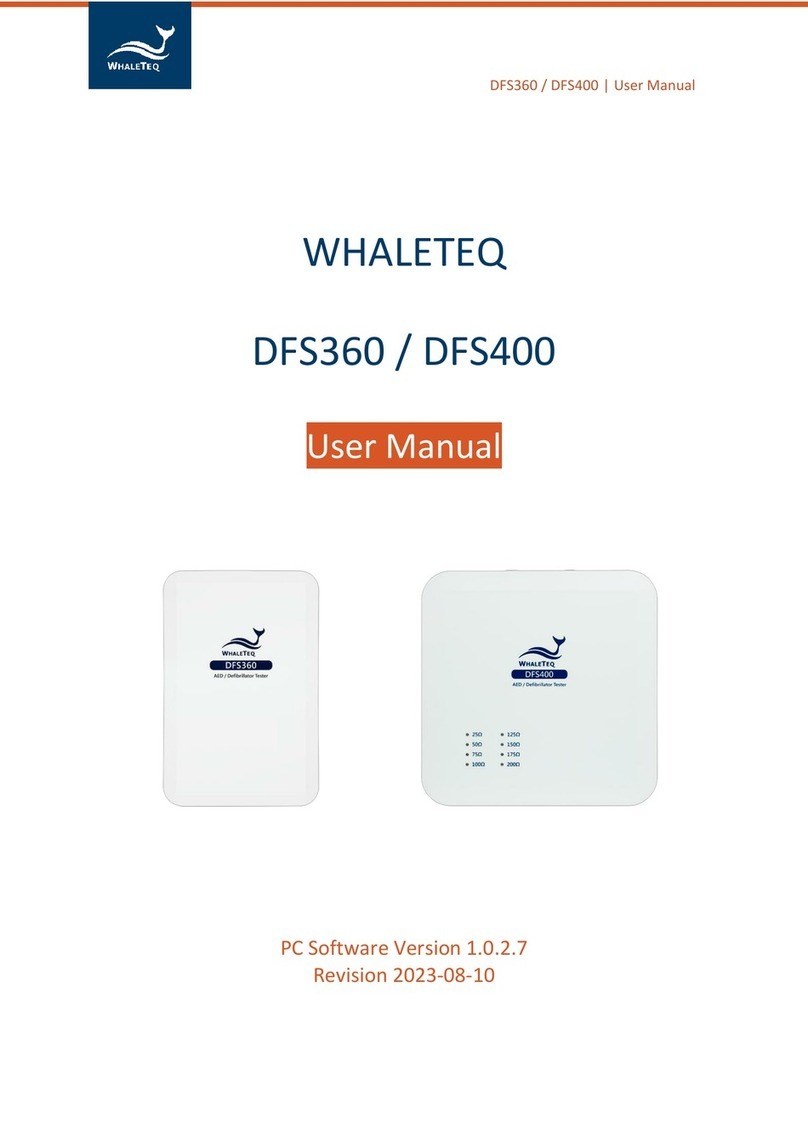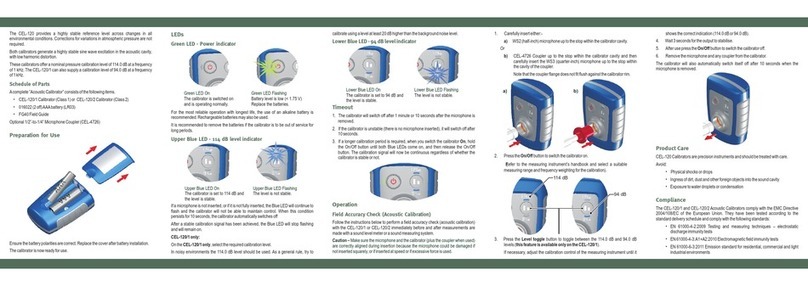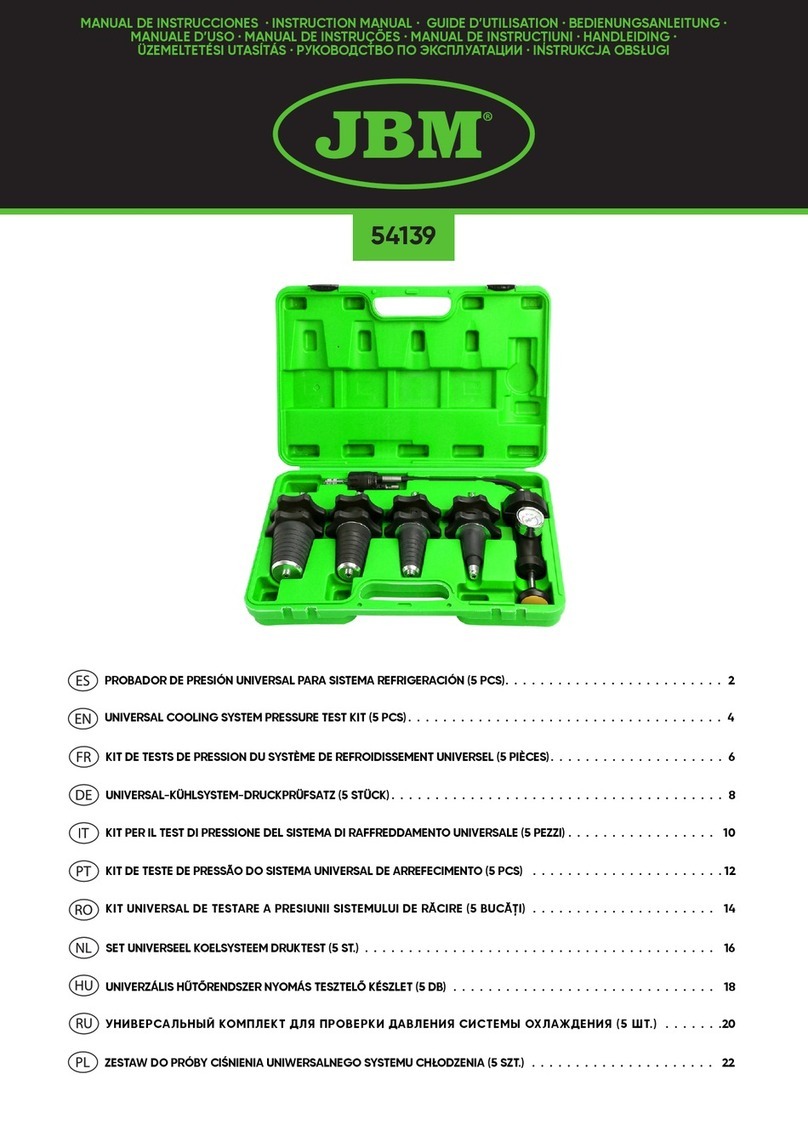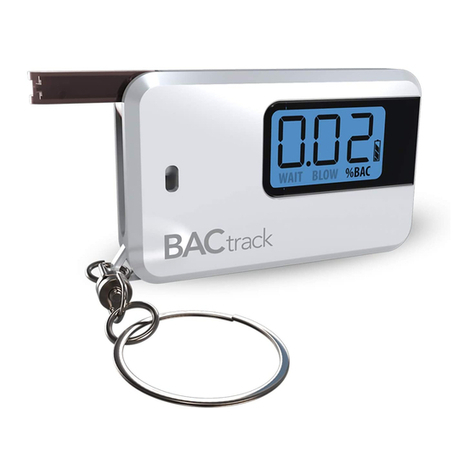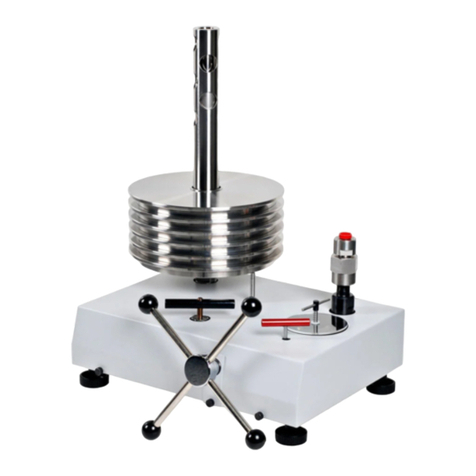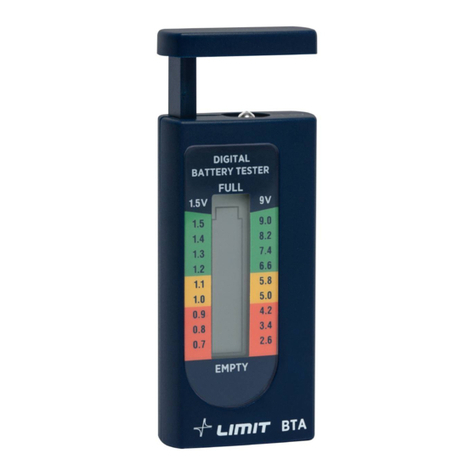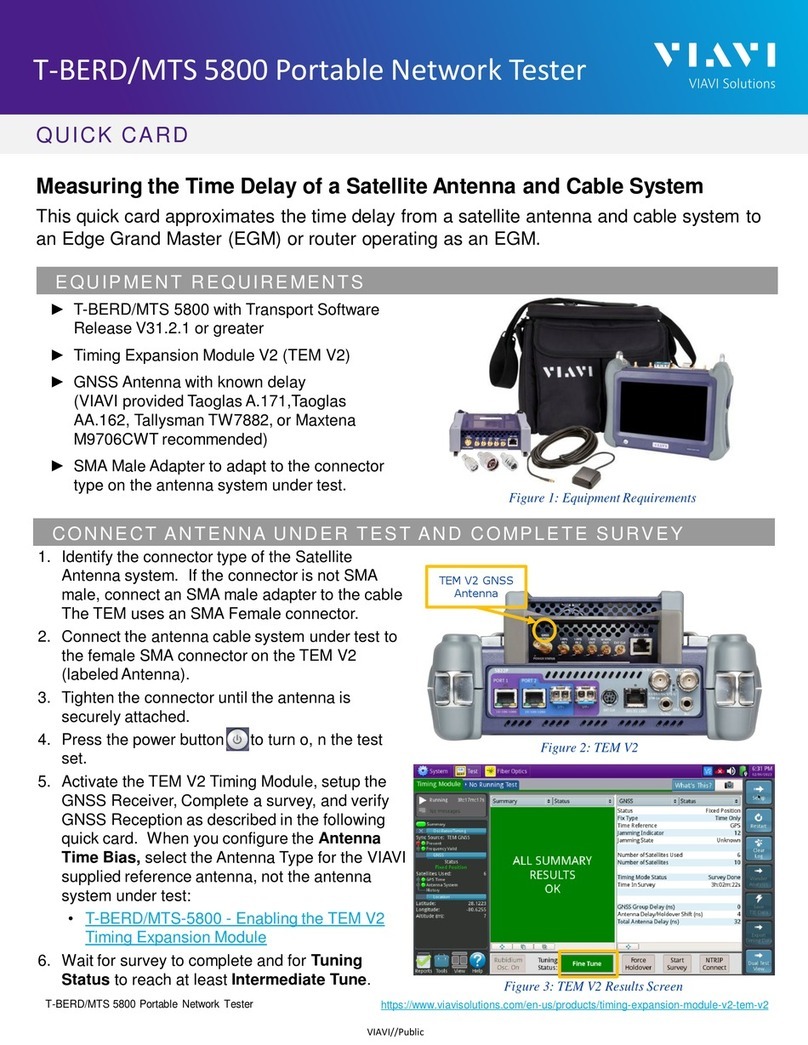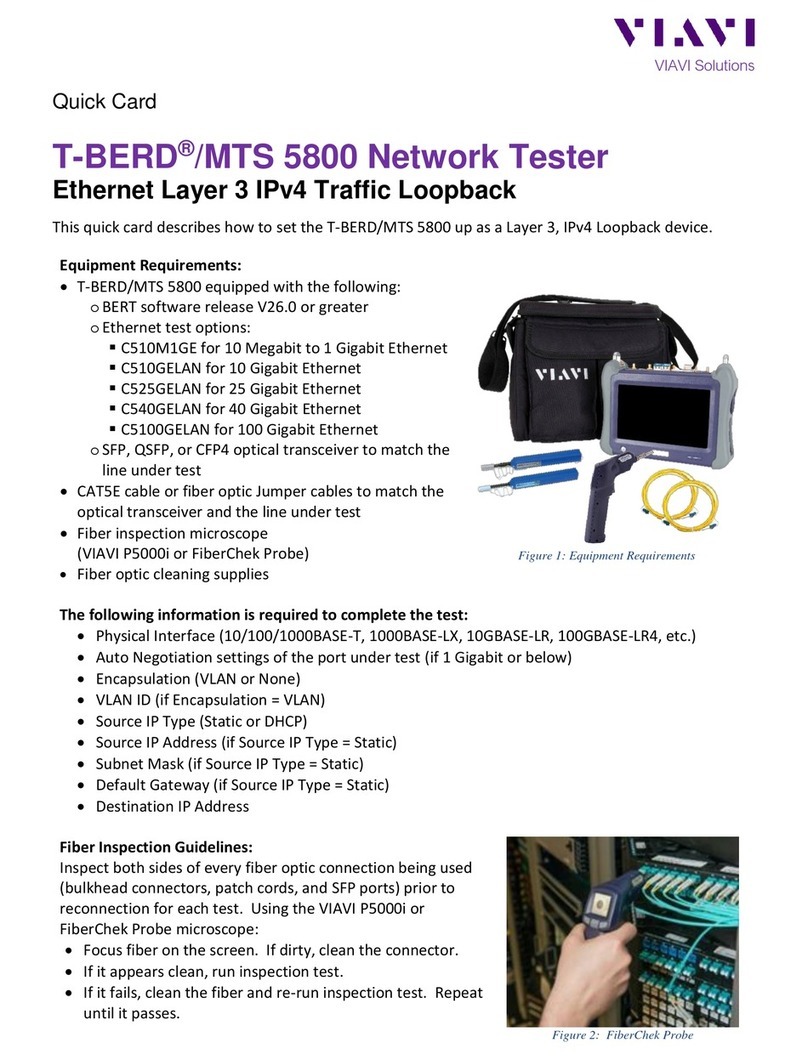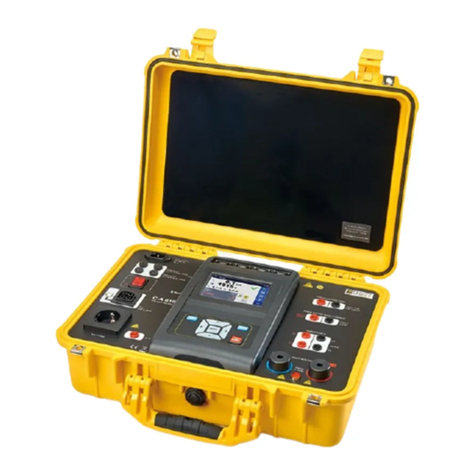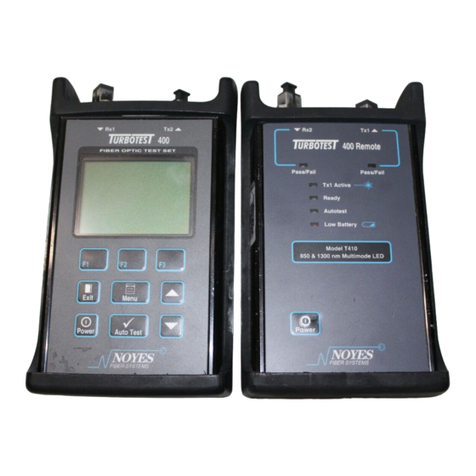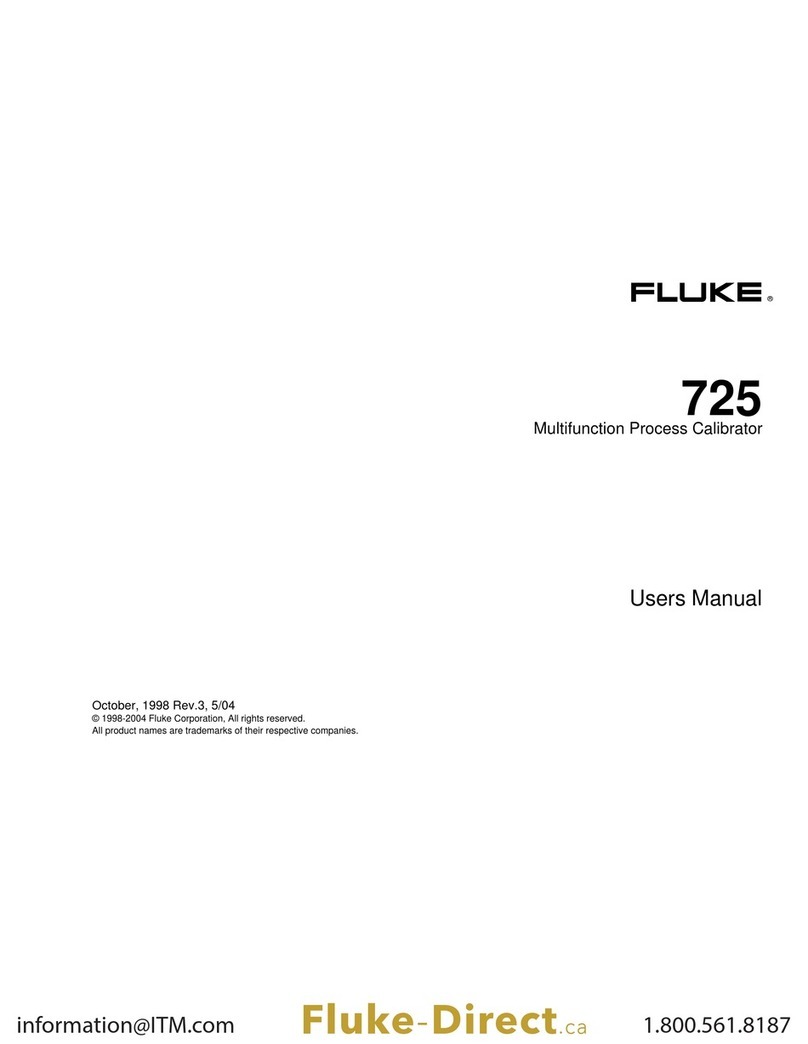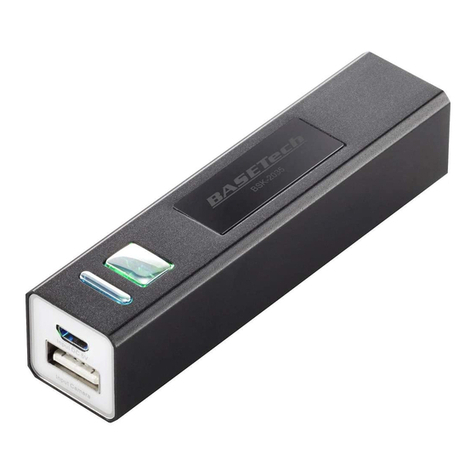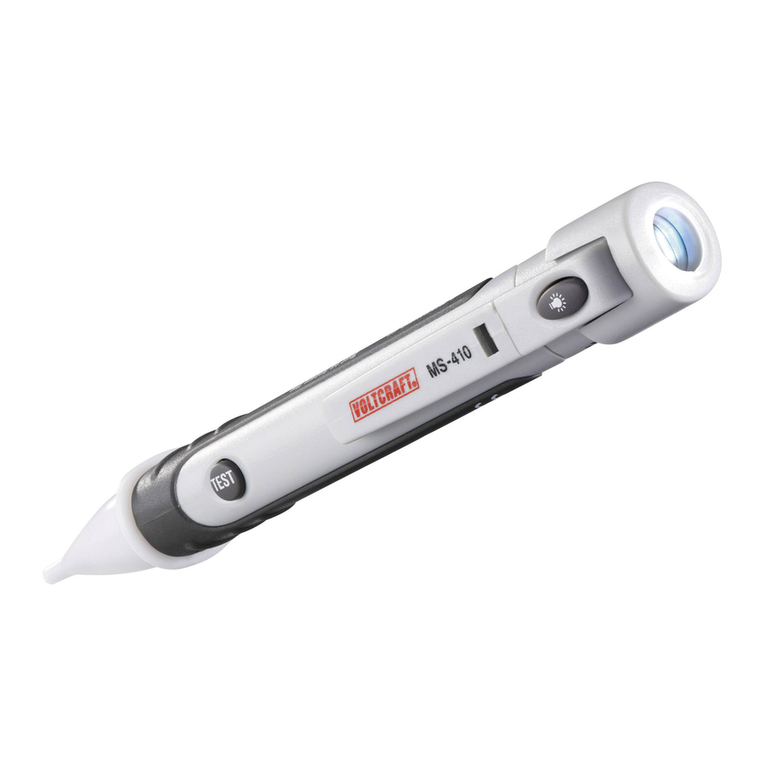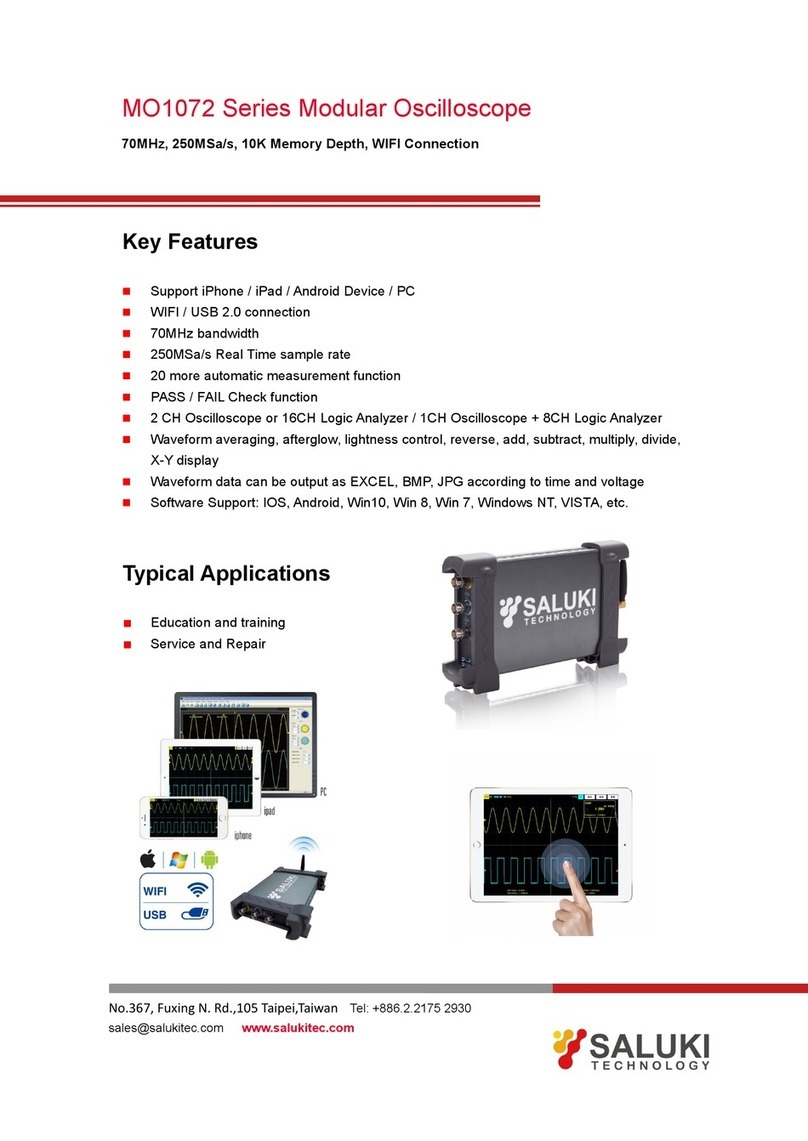IET Labs PRS-200 Series User manual

♦PRECISION INSTRUMENTS FOR TEST AND MEASUREMENT ♦
TEL: (516) 334-5959 • (800) 899-8438 • FAX: (516) 334-5988
www.ietlabs.com
534 Main Street, Westbury, NY 11590
IET LABS, INC.
PRS-200 SERIES
High Precision
Manual or SCPI Programmable
Decade Resistance Substituters
(IEEE-488.2 or RS232)
Operation Manual
Copyright 2005 IET Labs, Inc.
PRS200 IEEE.2 im/October, 2005

♦PRECISION INSTRUMENTS FOR TEST AND MEASUREMENT ♦
TEL: (516) 334-5959 • (800) 899-8438 • FAX: (516) 334-5988
www.ietlabs.com
534 Main Street, Westbury, NY 11590
IET LABS, INC.

i
WARRANTY
We warrant that this product is free from defects in material and workmanship and, when properly used, will
perform in accordance with applicable IET specifications. If within one year after original shipment, it is found
not to meet this standard, it will be repaired or, at the option of IET, replaced at no charge when returned to IET.
Changes in this product not approved by IET or application of voltages or currents greater than those allowed by
the specifications shall void this warranty. IET shall not be liable for any indirect, special, or consequential
damages, even if notice has been given to the possibility of such damages.
THIS WARRANTY IS IN LIEU OF ALL OTHER WARRANTIES, EXPRESSED OR IMPLIED, INCLUD-
ING BUT NOT LIMITED TO, ANY IMPLIED WARRANTY OF MERCHANTIBILITY OR FITNESS FOR
ANY PARTICULAR PURPOSE.

ii
WARNING
OBSERVE ALL SAFETY RULES
WHEN WORKING WITH HIGH VOLTAGES OR LINE VOLTAGES.
Dangerous voltages may be present inside this instrument. Do not open the case
Refer servicing to qulified personnel
HIGH VOLTAGES MAY BE PRESENT AT THE TERMINALS OF THIS INSTRUMENT
WHENEVER HAZARDOUS VOLTAGES (> 45 V) ARE USED, TAKE ALL MEASURES TO
AVOID ACCIDENTAL CONTACT WITH ANY LIVE COMPONENTS.
USE MAXIMUM INSULATION AND MINIMIZE THE USE OF BARE
CONDUCTORS WHEN USING THIS INSTRUMENT.
Use extreme caution when working with bare conductors or bus bars.
WHEN WORKING WITH HIGH VOLTAGES, POST WARNING SIGNS AND
KEEP UNREQUIRED PERSONNEL SAFELY AWAY.
CAUTION
DO NOT APPLY ANY VOLTAGES OR CURRENTS TO THE TERMINALS OF THIS
INSTRUMENT IN EXCESS OF THE MAXIMUM LIMITS INDICATED ON
THE FRONT PANEL OR THE OPERATING GUIDE LABEL.

Contents
WARRANTY .............................................................................................. i
WARNING................................................................................................. ii
CAUTION .................................................................................................. ii
Chapter 1: INTRODUCTION .................................................................... 1
Chapter 2: SPECIFICATIONS.................................................................. 3
2.1Model Configurationandspecifications ............................................................... 3
2.2Generalspecifications ......................................................................................... 4
Chapter 3: OPERATION........................................................................... 6
3.1Initial inspectionand setup................................................................................... 6
3.2Connection ......................................................................................................... 6
3.2.1GeneralConsiderations ....................................................................... 6
3.2.2Electrical Considerations ..................................................................... 6
3.2.3Four-WireKelvinLead Connections ................................................... 6
3.2.4Thermal emfConsiderations ................................................................ 6
3.3DialSetting ......................................................................................................... 7
3.4EnvironmentalConditions.................................................................................... 7
3.5Local Operation ................................................................................................. 7
3.6Remote Operation .............................................................................................. 7
Chapter 4: BCD INTERFACE OPTION.................................................... 8
4.1BCDProgramming ............................................................................................. 8
Chapter 5: IEEE INTERFACE OPTION.................................................. 10
5.1Introduction ......................................................................................................10
5.2Capabilities.......................................................................................................10
5.3AddressSwitchand Communications Settings ...................................................10
5.4IEEEOption Operation ....................................................................................10
5.5 GPIB Test Keyboard........................................................................................ 11
Chapter 6: SERIAL INTERFACE OPTION ............................................ 12
6.1Introduction ......................................................................................................12
6.2Capabilities.......................................................................................................12
6.3SignalInterfaceandCommunicationsSettings....................................................12
6.4SerialOption Operation ....................................................................................12
6.5SerialTest Keyboard ........................................................................................ 13
101402

Chapter 7: SERIAL INTERFACE OPTION ............................................ 14
7.1Introduction ...................................................................................................... 14
7.2CommandStringStructure ................................................................................ 14
7.3AdvancedProgramming - Software Drivers....................................................... 15
7.3.1DeterminingthePRSConfiguration.................................................... 15
7.3.2InstrumentInitialization ...................................................................... 15
7.3.3Source Impedance ............................................................................ 16
Chapter 8: MAINTENANCE................................................................... 17
8.1VerificationofPerformance ............................................................................... 17
8.1.1Calibration Interval............................................................................ 17
8.1.2GeneralConsiderations ..................................................................... 17
Appendix A ............................................................................................ 18
SCPI Command Reference................................................................... 18
Appendix B ............................................................................................ 20
IEEE-488.2 COMMON COMMANDS ...................................................... 20
Figures
FIGURE 2.1Typical OPERATING GUIDE Affixed to Unit....................... 5
Tables
Table 4.1 BCD INPUT Connector ........................................................... 8
Table 4.2 BCD INPUT Connector Pin Assignments ............................. 9

1
INTRODUCTION
PRS Series
Chapter 1
INTRODUCTION
The PRS Series (Figure 1.1) is a broad line of high
precision manual and programmable decade substi-
tuters. They provide direct resistance substitution as
well as RTD (Resistance Temperature Detector)
simulation, in a wide selection of ranges, tolerances
and ratings.
The PRS substituter is a precision resistance source
with excellent characteristics of stability, temperature
coefficient, and power coefficient. High dynamic
ranges are available, starting as low as 1 mΩ, and
extending to as many as 10 decades. These features
combined with a low virtually constant “zero resis-
tance” make for very versatile instruments.
The PRS Series features two optional special set-
tings. An “open circuit” and a “short circuit”. These
modes are useful for obtaining reproducible transi-
tions between settings, i.e. break-before-make or to
short between settings. The “short circuit” setting
also provides a reduced zero resistance.
Operation is both local using convenient direct-read-
ingfront panel thumbwheel switches,and remote with
optional parallel BCD, RS-232, or IEEE-488 inter-
faces. Both can provide an optional extra “10” posi-
tion for each decade.
The PRS Series employs very low resistance, low
thermal emf relays with gold-clad silver-alloy con-
tacts. A special design keeps contact resistance to a
minimum. The gold plating keeps the silver contacts
from becoming tarnished when unused, or when only
low currents are passed through them. This is most
often the case when only minute test currents are
drawnbydigital multimetersandothertestinstruments.
Contact resistance remains low and repeatable.
High-quality gold-plated tellurium-copper five-way
binding posts serve to minimize the thermal emf ef-
fects, which would produce errors in dc resistance
measurements. All other conductors within the in-
strument, as well as the solder employed contain no
metals or junctions that could contribute to thermal
emf problems.
With a resolution as low as 1 mΩand a maximum
available resistance of over 100 MΩ, the PRS-202
Series may be used for exacting precision measure-
ment applications requiring high accuracy, good sta-
bility, and low zero resistance. They are suited for
automatic and manual calibration and testing, simu-
lationof RTD’S, programmable loads,and many other
laboratory and industrial applications.
The PRS Series may be rack mounted to serve as
components in measurement and control systems.
Figure 1.1: High Precision Manual or
ProgrammableDecadeResistance Substituter

2INTRODUCTION
PRS Series
This page is intentionally left blank.

OPERATION
PRS-200Series
5
FIGURE 2.1Typical OPERATING GUIDE Affixed to Unit
(Please see label affixed to your unit)
PRS SERIES OPERATING GUIDE
WARNING
CONSULT INSTRUCTION MANUAL FOR PROPER INSTRUMENT OPERATION
Resistance Type: Metal film.
Range: 0 to 9,999,999 Ω, in 1 Ωsteps.
Accuracy: ±(0.1% + 30 mΩ), after subtraction of zero setting resistance; traceable to NIST.
Zero Resistance: <450 mΩ, <410 mΩ, typical; <560 mΩif OC (Open Circuit) option is
present; <20 mΩ, with SC (Short Circuit) option activated.
Maximum Load: 0.5 A, or 200 V (dc + peak ac), or 1 W/step, whichever applies first.
Interface: IEEE-488.2-1987,SCPI 1994.0; front panel switch selects REMOTE or LOCAL
operation; "*IDN"for S/N, Model & REV; "CAL:DATe?"for last calibration date.
Ground: GND terminal on front panel is connected to both chassis and earth ground.
Operation: Unit should be allowed to stabilize for one hour. For maximum stability, allow
unit to warm-up over two hours and keep free from mechanical disturbances.
Observeallsafety ruleswhenworkingwithhighvoltagesorlinevoltages.Connecttheshieldtoearthground
in order to maintain the case at a safe voltage. Whenever hazardous voltages (>45 V) are used, take all
measurestoavoidaccidentalcontactwithanylivecomponents:a)Usemaximuminsulationandminimize
theuse ofbareconductors. b) Removepowerwhenadjusting switches. c)Postwarning signsandkeep
personnelsafelyaway.
CAGECODE:62015 www.ietlabs.com
IET LABS, INC.IET LABS, INC.
IET LABS, INC.IET LABS, INC.
IET LABS, INC. • 534 Main Street, Westbury, NY 11590 • (516) 334-5959 • (800) 899-8438
PRSBLBL/p27/PRS201-1W-IEEE.2/10-02
SN: G2-XXXXXXX
FUSE: 0.25 A MODEL: PRS-201-1W-IEEE.2
POWER: 105-125 V, 50-60 Hz

6
PRS Series
OPERATION
Chapter 3
OPERATION
The GND terminal on all models is connected to the
case and to earth and chassis grounds. This may be
used as a shield terminal.
3.2.2ElectricalConsiderations
The performance of the PRS is directly affected by
the quality of the connection to the system under test.
Thisis particularly true with the precision series mod-
els having higher-accuracy and/or lower-impedance
decades.
For optimum performance, contact resistance should
be kept to a minimum by using the most substantial
mating connection possible, and by assuring that the
connection is well secured to the binding posts.
3.2.3Four-WireKelvinLead Connections
4-wire Kelvin leads minimize the effects of contact
resistance and approach ideal performance. The
CURRENT and SENSE HI/LO terminal pairs may
be shorted together to provide a 2-terminal connec-
tion in instances where high accuracy is not a con-
cern.
3.2.4ThermalemfConsiderations
The PRS Series uses high-quality, low-emf compo-
nents.Thermal emfis primarily attributableto thetem-
perature difference between the leads of the relay
and the contacts when temperature is applied to the
coil. This emf is of the order of 5 µVper relay, but is
not usually additive. The typical worst case is <15
µV.
3.1 Initial inspection and setup
This instrument was tested and carefully inspected
before shipment. It should be in proper electrical and
mechanical order upon receipt.
An OPERATING GUIDE is attached to the case
of the instrument to provide ready reference to speci-
fications.
Mountthe unit in astandard 19" rack ifthe rack mount
option is specified.
3.2 Connection
3.2.1General Considerations
The PRS Series Decade unit is built in 3-terminal or
5-terminal versions. The binding posts are standard
laboratory type and readily accept banana plugs, tele-
phone tips, spade lugs, alligator clips, and bare wire.
Binding posts are located on the front panel of the
instrument unless specifically ordered with a Rear
Outputoption.
The 3-terminal version posts are labeled HI,LO, and
GND. The HI and LO terminals are connected to
the ends of the internal impedance being set.
5-terminalmodels provide four Kelvin terminals con-
sisting of a CURRENT and a SENSE pair, each
labeled HI and LO. These minimize contact resis-
tance.
PRS-202 IEEE.2/05-12-05

OPERATION
PRS Series
7
If the effect of tens of microvolts is significant to your
application, connect to the instrument with low-ther-
mal-emf materials only. Copper wire and copper al-
loys are recommended; brass and steel should be
avoided. Tinned copper and solder are acceptable.
This emf will not be reflected if an ac measurement
instrument is employed, and can be eliminated by us-
ing a meter with “True Ohm” capability. In other
cases, the emf may represent a very small compo-
nent of a dc resistance measurement.
3.3 Dial Setting
Each decade is manually controlled via a front panel
thumbwheel that provides positions for “0” through
“9”. The total impedance is set/read directly from the
dial setting. The decimal point, if any, is marked on
the thumbwheel switches, and the steps are clearly
markedonthe panel.Short Circuit/ OpenCircuit mode
control is only available using a Remote control op-
tion.
3.4 Environmental Conditions
The PRS is built, calibrated and intended for use in a
laboratory environment with a nominal ambient tem-
perature near 23oC. The accuracy of the unit may be
affected when operated in non-laboratory environ-
ments.Always allowthe instrumenttostabilize atroom
temperature after unpacking or relocating the instru-
ment. Humidity should be maintained at laboratory
conditions.
3.5 Local Operation
Operation of the PRS substituter is straightforward
and graphically represented on the front panel.
1. Turn on the POWER switch. The POWER
indicator lamp, if present, should come on.
If a REMOTE option is present, the
READYand LOCALindicators should il-
luminate.
2. SettheREMOTE/LOCALswitch toLOCAL.
3. Connect any desired instrumentation to the
front panel binding posts. The GNDtermi-
nal may be connected to the ground of ex-
ternalequipment. TheGNDterminaliscon-
nected to the case and to both chassis and
earth grounds.
4. Make 4-terminal or 2-terminal connections
as described previously. A shielded set of
cables is recommended whenever ac op-
eration or high resistance are involved.
5. Set the thumbwheel switches to provide the
desired impedance in the units indicated on
the front panel.
3.6 Remote Operation
The PRS includes a REMOTE/LOCAL switch on
the front panel. The REMOTE position is a remote
enable. When in LOCAL mode, the PRS supplies
the impedance value selected using the front panel
thumbwheel switches.
When the switch is in the REMOTE position, the
PRS will supply the configured remote impedance
value only if that option asserts remote control. If
theoption doesnot assertcontrol, thefront panelthum-
bwheel impedance value is supplied. The REMOTE
and LOCAL LEDs always indicate which interface
is controlling the impedance value.
Setting the front panel REMOTE/LOCAL switch
to LOCAL overrides the REMOTE option settings
and always sets the supplied impedance to the value
selected using the front panel thumbwheels, regard-
less of the REMOTE option’s assertion of control.
The REMOTE BCD option sets impedance values
and asserts control using TTL logic. The impedance
values are BCD encoded as shown in table 4.2.
For IEEE and RS232 units, the LOCAL indicator
remainson untilcommunication withthe unit isinitial-
ized. The mode changes to REMOTE after con-
troller commands are received.

8
PRS Series
BCDINTERFACEOPTION
Chapter 4
BCD INTERFACE OPTION
4.1 BCD Programming
PRS units, with BCD interface option, come with a
BCD (Binary Coded Decimal, 1-2-4-8 coding) re-
mote programming capability accessed through the
BCD INPUT connector
The connector is a 50-pin, female, parallel-interface
industry-standard connector found on the rear panel.
Table 4.1 shows the connector pin numbering . Table
4.2 gives the pin assignments for the BCD input for
this connector. There can be as many as 10 digits to
be input. For any unit with fewer than 10 digits, only
the implemented subset of these will be operational.
All other digits may be ignored, and the associated
pins may be left open or shorted to ground.
Once the unit is switched to REMOTE with the front
panel knob, it may be set to either LOCAL or RE-
MOTE states under external control by properly se-
lecting pins 21 and 22 on the BCDINPUTrear panel
connector as shown in Table 4.1. Note that both pins
must be set. The REMOTE and LOCALled’s will
respond accordingly. Once the PRS is set to Re-
mote,the thumbwheel switches become disabled,and
impedance control is transferred to the rear panel
connector.
Inaddition, two special optional functionpins are pro-
videdto setthe unitto Open-circuitor (optional)Short-
circuit states across the HI and LO terminals on the
front panel. Applying a low to pin 34 activates an
open circuit condition. If the short circuit option is
present (this option provides a lower resistance short
circuit than a zero setting), applying a high to pin 35
provides a short circuit. If these functions are not
required, these two pins may be left open, or the op-
posite logic levels may be applied, i.e. high to pin 34
and low to pin 35. If both pins are activated, the
system will be in the short-circuit mode. If the short-
circuit option is not present, pin 20 may be left in any
state.
Table 4.1 BCD INPUT Connector
(Viewed from rear of instrument)
25 24 ……………. 21
50 49 ……………. 27 26

9
PRS Series
BCDINTERFACEOPTION
Table 4.2 BCD INPUT Connector Pin Assignments
Pin
No. BCD Code
Wei
g
ht Function
30 1
31 2
32 4 0.01-0.09Ω
33 8
43 1
42 2
41 4 0.1-0.9 Ω
40 8
39 1
38 2
37 4 l-9 Ω
36 8
47 1
46 2
45 4 10-90 Ω
44 8
41
32
2 4 100-900 Ω
18
81
72
6 4 1-9 kΩ
58
12 1
11 2
10 4 10-9O kΩ
98
16 1
15 2
14 4 100-900 kΩ
13 8
20 1
19 2
18 4 l-9 M Ω
17 8
29 1
28 2
27 4 10-90 M Ω
26 8
34 Open-circuit control
35 Short-circuit control
(optional)
23 Earth ground
24 +5V, l0 mA maximum
25 Earth ground
21 LOCAL/REM OTE select
22 LOCAL/REM OTE select
48 Reserved for IEEE-488
49 Reserved for IEEE-488
50 Reserved for IEEE-488
Low for LOCAL; High for REM OTE
Description
Low to activate; otherwise high or open.
High to activate; otherwise low or open; If option
is absent, pin may be in any state.
High for LOCAL; Low for REM OTE

10
PRS Series
IEEE INTERFACE OPTION
Chapter 5
IEEE INTERFACE OPTION
5.1 Introduction
The IEEE interface option makes the PRS-200 a
IEEE-488.2-1987and SCPI 1994.0compatible instru-
ment.
The IEEE STD 488.2 covers the electrical and me-
chanical bus specifications, and state diagrams for
each GPIB bus function. It also establishes data for-
mats, common commands for each 488.2 device and
controller protocols. The standard is available on-line
at http://www.ieee.org or by contacting the IEEE at:
IEEE Corporate Office
3 ParkAvenue, 17th Floor
New York, New York
10016-5997 U.S.A.
Tel: +1 212 419 7900
The SCPI standard provides a tree like series of stan-
dardcommands for programmable instrumentsso that
similar instruments by different manufacturers can
be controlled by the same program. SCPI informa-
tion and a command reference are located inAppen-
dixA.
Other tutorials are available on-line; consult IET for
additional information.Asoftware GPIB “keyboard”
may be requested from IET to perform elementary
commands for training and testing. See Section 5.5.
5.2 Capabilities
TheIEEEoption providesremote controlover allfunc-
tions except POWER.
Decimal
Address SWITCH
SETTINGS
5-4-3-2-1
Decimal
Address SWITCH
SETTINGS
5-4-3-2-1
0 0-0-0-0-0 16 1-0-0-0-0
1 0-0-0-0-1 17 1-0-0-0-1
2 0-0-0-1-0 18 1-0-0-1-0
3 0-0-0-1-1 19 1-0-0-1-1
4 0-0-1-0-0 20 1-0-1-0-0
5 0-0-1-0-1 21 1-0-1-0-1
6 0-0-1-1-0 22 1-0-1-1-0
7 0-0-1-1-1 23 1-0-1-1-1
8 0-1-0-0-0 24 1-1-0-0-0
9 0-1-0-0-1 25 1-1-0-1-0
10 0-1-0-1-0 26 1-1-0-1-0
11 0-1-0-1-1 27 1-1-0-1-1
12 0-1-1-0-0 28 1-1-1-0-0
13 0-1-1-0-1 29 1-1-1-0-1
14 0-1-1-1-0 30 1-1-1-1-0
15 0-1-1-1-1 31 Reserved,
do not use
5.3 Address Switch and
Communications Settings
Each GPIB bus device is identified by a five-bit bi-
naryaddress. There are 32 possibleprimary addresses
0 through 31; addresses 0 and 31 are reserved . The
PRS BUS ADDRESS switch on the rear panel es-
tablishes the GPIB address of the unit. Bus address
settings are read at power up. Refer to table 5.1.
5.4 IEEE Option Operation
The IEEE controller asserts the remote mode upon
receipt of a valid command. The REMOTE LED
will light and impedance settings will be controlled
Table 5.1 IEEE Bus Address Settings

11
PRS Series
IEEE INTERFACE OPTION
through the IEEE interface if the REMOTE/LO-
CAL switch is in the REMOTE position. Remote
controlmay be droppedby issuing anIEEE GTL com-
mand. Dropping remote sets the PRS output to the
value set on the front thumbwheel switches. See
Chapter 3 for information about REMOTE/LOCAL
functionality.
5.5 GPIBTest Keyboard
To aid the user in operating the PRS, a GPIB “Key-
board” Controller program - the easiest way to con-
trolGPIB devices withoutwriting a program -is avail-
able from IET. This GPIB Keyboard program auto-
matically finds your device at start-up and it lets you
enter just the data that you want to send to the de-
vice. This program works with ICS, Measurement
Computing and National Instruments controllers.
To implement, request a download of
ICS_GPIBkybd_Install.zip from IET Labs Tech
Support.
Unzip the file and follow instructions to install.
Open the application. You may use the Find Listen-
ersbutton to confirm that the PRS unit is recognized.
Otherinstruments may also berecognizedat this time.
Enter and set the Address to the PRS address. Use
the window to send a command string to the PRS,
wherethe command string is constructed as described
in Chapter 7. A command string might be, for ex-
ample:
SOURce:DATA resistance string

12
PRS Series
SERIAL INTERFACE OPTION
Chapter 6
SERIAL INTERFACE OPTION
IET Direction
Pin RS232 Signal Name
In / Out
1 AA Chassis n/a
2 BA SendData !
3 BB ReceiveData "
4 CA Requestto Send !
5 CB Clearto Send "
8 CF SignalDetected "
20 CD DataTerminalRdy !
6.4 SERIAL Option Operation
The SERIAL option uses the same command set as
the IEEE option.Additional commands exist for con-
figuring the serial interface. Changes to the serial
UART take place at power-on or after a reset.
SCPI command strings must be followed by a <CR>
to terminate the message. Every command returns a
response that includes a message terminator. The pro-
gram/operator should wait for this message termina-
tor before sending additional commands.
Command characters are not echoed to the interface
on power up. Send <CTRL-E> to force the control-
ler to echo commands back to the interface or
<CTRL-F> to disable echo.
By default, the controller returns ">" and <LF> as a
prompt after executing any command. When echo is
turned 'On', the controller returns <CR><LF> and
">"as a prompt after executing any command.
Echo-back RS232 Message
Mode Prompt Terminator
On CR LF > CR LF
Off >LF LF
6.1 Introduction
The SERIAL option adds RS-232C and SCPI 1994.0
capability to the PRS series instruments. The SCPI
standard provides a tree like series of standard com-
mands for programmable instruments so that similar
instruments by different manufacturers can be con-
trolled by the same program.A PRS SCPI command
reference is included inAppendixA.
Tutorials are available on-line; consult IET for addi-
tionalinformation.AsoftwareSerial “keyboard” may
be requested from IET to perform elementary com-
mands for training and testing. See Section 6.5.
6.2 Capabilities
The SERIAL option provides remote control over all
functions except POWER.
6.3 Signal Interface and
Communications Settings
A 25 pin male DTE interface connector conforming
with EIA-STD-RS-530 is located on the rear-panel.
The default communications parameters are:
Connection of a PC to the PRS SERIAL option is
typically made through a simple null-modem or
“LapLink” cable.
Parameter Default Range/Choices
Baud 9600 300 - 115,200
Data Bits 8 7 or 8
Stop Bits 1 1 or 2
Parity None Odd, Even, None

SERIAL INTERFACE OPTION
PRS Series
13
6.5 SerialTest Keyboard
To aid the user in operating the PRS, a Serial “Key-
board” Controller program - the easiest way to con-
trolserial devices without writing aprogram - is avail-
able from IET. This Serial Keyboard program auto-
matically finds your device at start-up and it lets you
enter just the data that you want to send to the de-
vice. This program works with ICS, Measurement
Computing and National Instruments controllers.
To implement, request a download of:
ICS_Serkybd_Install.zip, from IET Labs Tech
Support
Unzip the file and follow instructions to install.
Open the application. Initialize the COM PORT and
use the Device Command window to send a com-
mand string to the PRS, where the command string
is constructed as described in Chapter 7.Acommand
string might be, for example:
SOURce:DATA resistance string
8-25-05

14
PRS-200Series
PROGRAMMING
Chapter 7
PROGRAMMING
Forexample:
Value Command
600,567.9 ΩΩ
ΩΩ
ΩSOURce:DATA 0006005679
2,700,000 ΩΩ
ΩΩ
ΩSOURce:DATA 0027000000
Values sent for decades not implemented in the PRS
are ignored. Setting a PRS with 4 decades and a mini-
mum resolution of 1,000.0 Ωto 10,600,567.9 would
result in an actual value of 600,000 Ω. For example:
Command Value
SOURce:DATA 0106005679 600,000 ΩΩ
ΩΩ
Ω
Optional OpenCircuit (OC)and ShortCircuit (SC)
are implemented as standard decades positioned at
the Most Significant Decade plus one. For example,
the Resistance String for the Open circuit and Short
circuit modes for a unit with a total of 7 decades are:
Open circuit SOURce:DATA 001XXXXXXX
Short circuit SOURce:DATA 002XXXXXXX
(where X = any Resistance String)
OC and SC modes may be used to create a “con-
trolled transition” between two values without con-
cern for transitional switching of the relays.
• Output command for R1.
• Output command for R1 plus a SC Mode Character.
• Output command for R2 plus a SC Mode Character.
• Output command for R2.
This technique also applies to the Open circuit mode.
OC/SC mode Character =
0, 4, 8, or absent for NORMAL operation
1, 5, or 9for OPEN CIRCUIT operation -optional
2,3,6,or7forSHORTCIRCUIT operation-optional
7.1 Introduction
PRS-200 units equipped with IEEE or SERIAL op-
tions implement a consistent SCPI interface.ASCPI
command reference is included inAppendixA.
7.2 Command String Structure
Outputis controlled in the form of a single SCPI com-
mand followed by a space and a 10 character Resis-
tance String. Each character in the string represents
the value of one decade, equivalent to one possible
manual thumbwheel switch on the front of the unit.
This Resistance String is constructed as:
• The number is in units of 0.1 ΩΩ
ΩΩ
Ω.
• All 10 characters must be provided; the active charac-
ters are the ones that match the front panel thumb-
wheel decades.
• The decade values are straight-reading, from left to
right.All preceding and trailing zeros must be included
tocomplete10 characters; any other characters in those
spaces will be ignored.
• A decimal point may not be included.
The Resistance String has a minimum resolution of
0.1 Ωwith this decade assigned tothe right-most char-
acter in the string. To create the SCPI command:
• Multiply the desired value, in ohms, by 10
• Convert the integer portion of the value to a string,
• Pre-pend 0’s to create a 10 character Resistance String
• Combine with the “SOURce:DATA ” command.

PROGRAMMING
PRS-200Series
15
7.3 Advanced Programming -
Software Drivers
Basic control of a PRS can be automated by writing
a function that accepts a numeric value and converts
it to the string using the method described previously.
If the PRS is to be used in an automated environment
where various models and options may be installed or
where interchangeability is a requirement, a driver
can be written that abstracts the device specific func-
tions from the test sequence.
The PRS family of instruments are available in many
models (including inductance, resistance and capaci-
tance) ranges, (1milliOhm to 10MegaOhm) and with
various options. Information to create a more robust
driver to control a PRS instrument is listed below.
7.3.1DeterminingthePRSConfiguration
The IEEE 488.2 specification defines the *IDN string
as containing 4 sections separated by commas; the
manufacturer, the model, the serial number and the
revision of the instrument.
The Model section of the *IDN string of the PRS has
been encoded to provide information about the char-
acteristics of the specific instrument being used. For
example, a *IDN query to a PRS might return:
IET Labs,PRS-200-F-6-100m-0-0,D6-
0211201,D6
In our example above, the Manufacturer section con-
tains “IET Labs”, the Model section contains “PRS-
200-F-6-100m-0-0”, the Serial Number section “D6-
0211201” and the Revision section “D6”. The model
is split into 7 parts with dashes to identify:
Type
Version
Tolerance
Number of Decades
Least Significant Decade
Slot of LSD
Options
Type: PRS Resistance Substituter
Version:
200
201
202
Tolerance:
X: 0.01%
Q: 0.02%
A: 0.05%
B: 0.1%
C: 0.5%
F: 1%
G: 2%
H: 4%
LSD: 1m 1milliOhm
10m 10milliOhm
100m 100milliOhm
1 1 Ohm
10 10 Ohm
100 100 Ohm
1K 1 KOhm
10K 10 KOhm
100K 100 KOhm
1M 1 MegaOhm
10M 10 MegaOhm
Note: micro and Mega Ohms use the same
suffix letter; case indicates magnitude.
Open Cicuit / Short Circuit Option:
0 notequipped
1 Open Circuit option present
2 Short Circuit option present
3 Both OC/SC present
7.3.2InstrumentInitialization
Reset the unit to power up defaults using *RST
Check that the instrument is “in cal” by reading the
calibration date and compare it to current date/time
using CALibrate:DATe?

16
PRS-200Series
PROGRAMMING
Read the IDN string from the PRS
Parse the IDN string to extract the IDN String Model
(second) section. Parse this further to determine:
let iType= type of device (R,L,C,RTD; enum 0-3)
let iModel = model (200,201,202; enum 0-2)
let iTol = tolerance (see section 7.3.1; enum 0-10)
let iDec = value of “Number of Decades”
let nMin = numeric value of LSD (see section 7.3.1)
let locLSD = location of the LSD on system board
let iOption = options installed (see section 7.3.1)
let iMax =(iMin*10**nDec)
Calculate iMax. In our example, the LSD is 100m or
0.1 Ohms and the number of decades is 6
iMax=(0.1*10**6)-iMin; oriMax =99,999.9
7.3.3Source Impedance
Range test the desired output value against iMin and
iMax. Coerce the supplied value to the max or min,
return an error code, or use optionally equipped OC/
SC features per your needs.
Example1:
letiModel= 0 (model 200/201 system board)
let iValue equal 123.51
iValue is < 99,999.9 and > 0.1;
therefore iValue = 123.51
Example2:
let iModel = 1 (model 202 system board)
letiValue equal 1,000,000
iValue is > 99,999.9;
if iOption = 1 or 3 then iValue = 100,000.0
else iValue = 99,999.9
Multiply iValue by one over iMin to shift the digits
below the operating range of the PRS to the right of
the decimal point (in this case, 10). Select the integer
portionofiValue
Example1:
iValue=iValue*(1/iMin)
iValue=123.51*(1/.1); or iValue = 1235.1
iValint=int(iValue);oriValint =1235
Example2:
iValue=iValue*(1/iMin)
iValue=100,000*(1/.1);oriValue=1,000,000.0
iValint = int(iValue); oriValint= 1000000
Shift this value to align it with the location of the first
decadein the PRS.locLSD from ourIDN string evalu-
ation is 1, so:
Example1:
iValint = iValint *(1*10^(locLSD))
iValint= 1235 * (1*10^(0))
iValint = 1235 * 1; or iValue = 1235
Example2:
iValint = iValint *(1*10^(locLSD))
iValint = 1000000 * (1*10^(0))
iValint = 1000000 * 1; or iValue = 1000000
Convert the number to a string value using a “for-
mat” function that includes leading zeros.A200/201
series unit has 10 decade locations, a 202 has 12.
prsCmd = “SOURce:DATA ” _
& format(iValue,“0000000000”)
Example1:
“SOURce:DATA0000001235”
Example2:
“SOURce:DATA000001000000”
Send the prsCmd string to the PRS.
Other manuals for PRS-200 Series
1
Table of contents
Other IET Labs Test Equipment manuals
